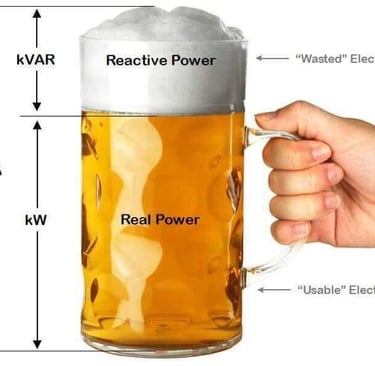Understanding Active Power, Reactive Power, and Apparent Power in Electrical Systems
ELECTRICAL
Mahmoud Sadek by AI
8/8/20252 min read


1. Active Power (P): The Useful Power
Active power, also known as real power or true power, is the portion of power that performs actual work in an electrical circuit. It is the energy consumed by resistive loads, such as heaters, incandescent lamps, and motors, to produce useful output like heat, light, or mechanical motion. Active power is measured in watts (W) and represented by the P.
In an AC (alternating current) circuit, active power is the product of the voltage (V), current (I), and the cosine of the phase angle (θ) between them. The formula expresses this relationship:
P=V×I×cos(θ)P=V×I×cos(θ)
Here, cos(θ)cos(θ) is known as the power factor, which indicates the efficiency of power usage in the circuit. A power factor of 1 (or 100%) means all the power is being used for useful work, while a lower power factor indicates inefficiency.
2. Reactive Power (Q): The Supporting Power
Reactive power, denoted by the symbol Q, is the portion of power that does not perform useful work but is essential for maintaining the voltage levels required to deliver active power. It is associated with inductive and capacitive loads, such as transformers, motors, and capacitors, which store and release energy in magnetic or electric fields. Reactive power is measured in volt-amperes reactive (VAR).
In an AC circuit, reactive power is the product of the voltage (V), current (I), and the sine of the phase angle (θ) between them:
Q=V×I×sin(θ)Q=V×I×sin(θ)
Reactive power is crucial for the proper functioning of many electrical devices, but it does not contribute to energy consumption. Instead, it oscillates between the source and the load, creating additional current flow that increases losses in the system. Utilities often charge penalties for low power factors because excessive reactive power can strain the electrical grid.
3. Apparent Power (S): The Total Power
Apparent power, represented by the symbol S, is the combination of active power and reactive power. It is the total power supplied to an electrical circuit, including both the useful and non-useful components. Apparent power is measured in volt-amperes (VA) and is calculated using the formula:
S=V×IS=V×I
Apparent power is a vector sum of active and reactive power, and it represents the total demand placed on the electrical system. The relationship between active power, reactive power, and apparent power can be visualized using the power triangle:
S=P2+Q2S=P2+Q2
The power triangle also illustrates the power factor, which is the ratio of active power to apparent power:
Power Factor=PSPower Factor=SP
Key Differences and Relationships
Active Power (P): Represents the actual energy consumed by the load. Measured in watts (W).
Reactive Power (Q): Represents the energy stored and returned by inductive or capacitive loads. Measured in VAR.
Apparent Power (S): Represents the total power supplied to the circuit. Measured in VA.
The relationship between these three types of power is best understood through the power triangle, where:
Active power is the horizontal component.
Reactive power is the vertical component.
Apparent power is the hypotenuse.
Importance in Electrical Systems
Efficiency: A high power factor (close to 1) indicates efficient use of electrical power, reducing losses and improving system performance.
Equipment Sizing: Apparent power determines the size of generators, transformers, and conductors required for an electrical system.
Voltage Regulation: Reactive power is essential for maintaining voltage stability, especially in long transmission lines.
Cost Savings: Reducing reactive power through power factor correction can lower electricity bills and minimize penalties imposed by utilities.
